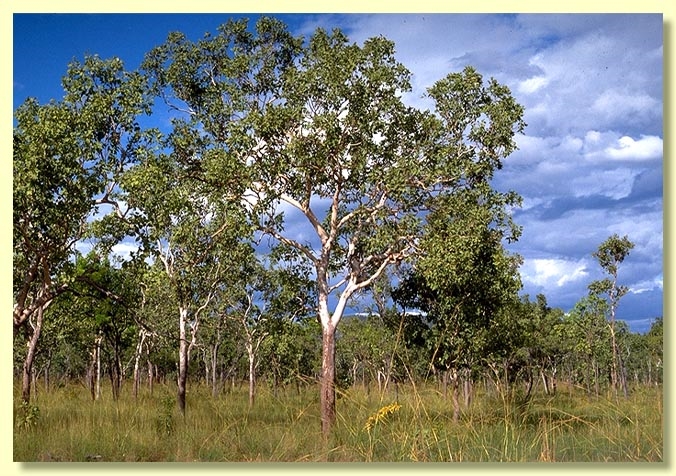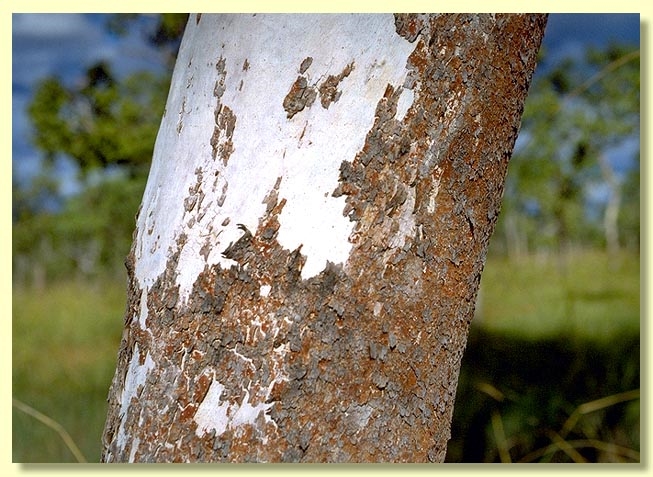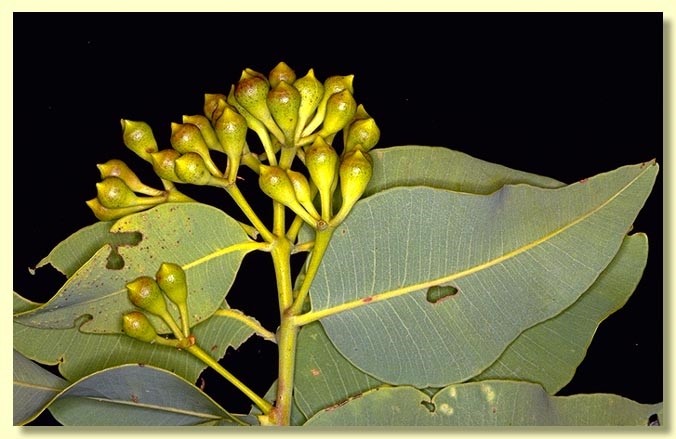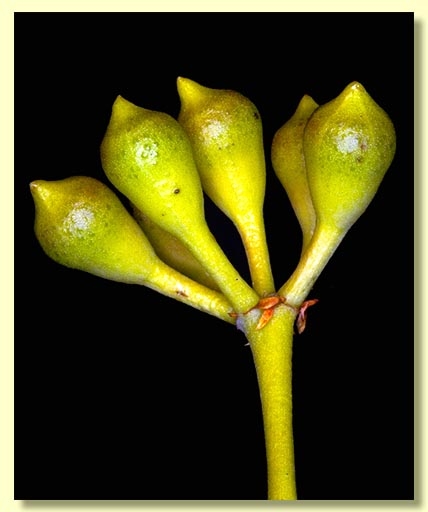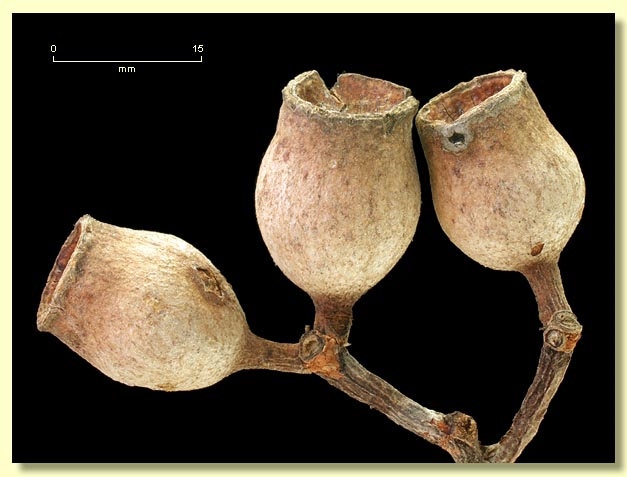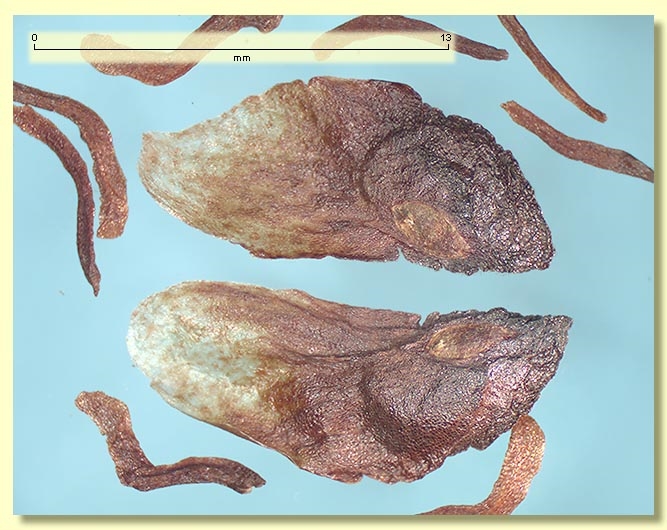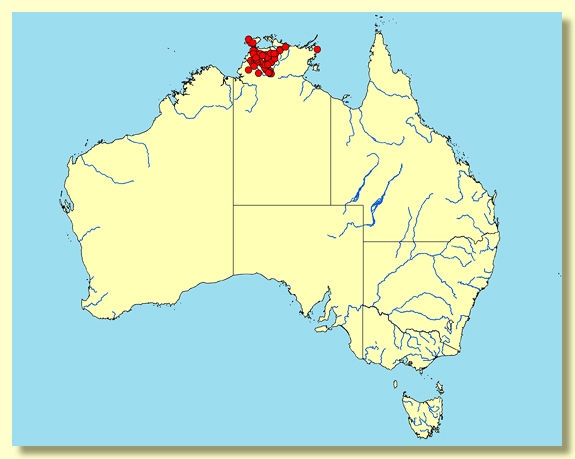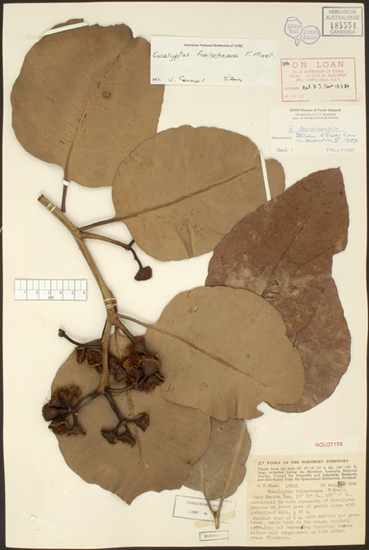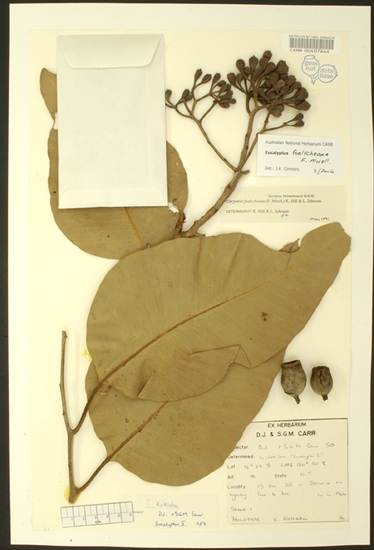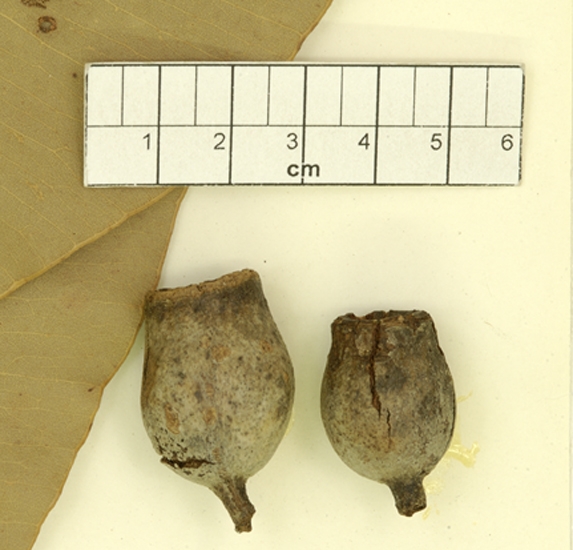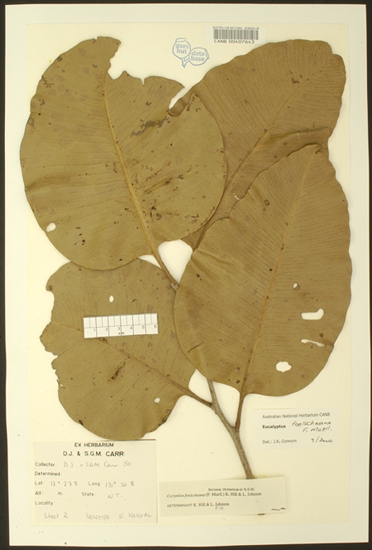Euclid - Online edition
Corymbia foelscheana
Corymbia | Rufaria
Corymbia foelscheana (F.Muell.) K.D.Hill & L.A.S.Johnson, Telopea 6: 333 (1995).
Eucalyptus foelscheana F.Muell., Chem. & Druggist 5 Australas. Suppl.: 56 (1882). T: Northern Territory: Port Darwin, 19 Sept.1882, P.Foelsche s.n.; lecto: MEL153998.
E. leiophloia Blakely & Jacobs in Blakely, Key Eucalypts: 82 (1934). T: Northern Territory: [N of] Umbrawarra, 5 July 1916, H.I.Jensen 417; lecto: NSW; isolecto: BRI.
E. leiophloia var. lepidophloia Blakely & Jacobs in Blakely, Key Eucalypts: 82 (1934). T: Northern Territory: track to Katherine River, July 1911, W.B.Spenser s.n.; holo: NSW10084.
Eucalyptus darwinensis D.J.Carr & S.G.M.Carr, Eucalyptus2: 131 (1987). T: Northern Territory: near Manton dam, 12°53’S, 131°5’E, 18 Aug 1946, S.T.Blake 16805; holo: CANB; iso: BRI.
Tree to 10 m tall. Forming a lignotuber. Dry season deciduous.
Bark thinly persistent and rough, ± tessellated, brown to grey or reddish, variably extending over the lower trunk, sometimes the whole trunk and occasionally the larger limbs, shedding in flakes above to show smooth white to cream and grey.
Branchlets lack oil glands in the pith; smooth.
Juvenile growth (coppice or field seedlings to 50 cm): stems rounded in cross-section, smooth; juvenile leaves always petiolate, opposite to sub-opposite or alternate, very large, orbicular to broadly ovate or ± oblong, 17–25 cm long, 15–18.5 cm wide, base truncate and sometimes uneven on either side of the petiole, apex usually rounded and apiculate, rarely emarginate, margin usually coarsely crenulate, undulate, dull, green, smooth.
Adult leaves predominantly alternate, sometimes a few sub-opposite to opposite pairs present, petioles 1.8–4(5.3) cm long; blade usually broadly ovate to broadly lanceolate, rarely deltoid or ± orbicular, (8)10–27.5 cm long, 4–13.5 cm wide, base truncate to rounded, tapering, or sometimes uneven on either side of the petiole, margin entire, apex rounded and apiculate or pointed, concolorous, dull, green, smooth, side-veins at greater than 45° to midrib (penniveined), reticulation very dense, intramarginal vein apparently absent (confluent with margin) or rarely visible and very close to margin, oil glands apparently absent.
Inflorescence terminal compound, less commonly axillary compound, rarely a few single axillary umbels, peduncles stout or relatively slender, rounded, 0.9–5 cm long, buds 7(9) per umbel, pedicels 0.5–1.4(1.7) cm long. Mature buds obovoid to pyriform, 0.9–1.4 cm long, 0.7–0.9 cm wide, smooth, scar absent (both opercula shed together at flowering), operculum shallowly rounded and sometimes umbonate, rarely the umbo slightly elongated into a beak, stamens inflexed, all fertile, anthers oblong, dorsifixed, versatile, dehiscing by longitudinal slits, style as long as or almost as long as floral cavity, straight, stigma blunt or papillose (mop like), locules 4, the vertical ovule rows indistinct on the placentae or ca 7. Flowers creamy white.
Fruit pedicellate (pedicels 0.3–1.7 cm long), urceolate with a vertical neck that is flared or not flared at the rim, 2.2–3 cm long, 1.4–2.4 cm wide, ± smooth, disc descending vertically or sometimes obliquely when the rim is flared, valves 4, enclosed.
Seeds brown, 10–15 mm long, ellipsoidal with terminal wing, hilum ventral.
Cultivated seedlings (measured at ca node 10): cotyledons large, reniform; stems rounded in cross-section, setose with bristle-glands; leaves always petiolate (petioles to 1 cm), opposite for 11 or more nodes, or becoming sub-opposite or alternate earlier, broadly elliptical to ovate, 8–12 cm long, 4–6 cm wide, base rounded to truncate, margin subcrenulate to entire, apex rounded or broadly acute, green, ± concolorous, sparsely setose by node 10 with bristle-glands only on the margin, midrib on underside and petiole.
Flowering has been recorded in January, April, May, June, October and December.
A small tree found in the monsoonal Top End of the Northern Territory, from Darwin south to Katherine and also on Melville Island. Locally abundant, it is often a dominant of savannah woodlands on sandy to gravelly soils, on plains, gentle slopes and footslopes to escarpments. Corymbia foelscheana has scaly thin rough bark on at least part of the trunk, a crown of relatively large dull green leaves and large urceolate fruit to 2.4 cm diameter.
C. foelscheana is sometimes confused with C. latifolia as both species have relatively large crown leaves that are dull, green and concolorous. C. foelscheana differs in having larger fruit (> 1.3 cm diameter) with a distinct neck compared with C. latifolia (fruit < 1.3 cm diameter and lacking a distinct neck). C. foelscheana has also been confused with C. greeniana (here including C. curtipes, C. dampieri and C. byrnesii ) but the latter has much narrower crown leaves ((1.2)2–7.6 cm wide), and has a more southerly distribution in drier areas, though still monsoonal, compared with the former.
Plants from the Kimberley Region of Western Australia previously regarded as C. foelscheana are here regarded as C. greeniana.
MORE ABOUT CORYMBIA
MORE ABOUT RED BLOODWOODS
Corymbia foelscheana: after Paul Foelsche (1831–1914). Paul Foelsche was born in Germany and migrated to Australia where he spent many years in what became the Northern Territory, as a policeman, coroner and magistrate. He took many photographs recording the early days of settlement in the Top End.

